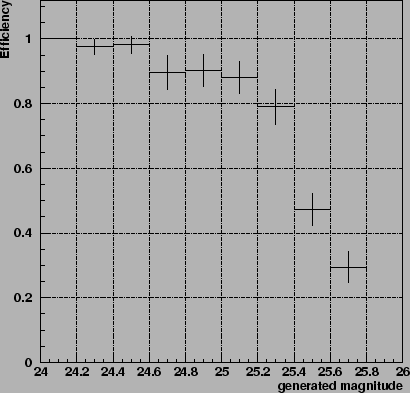Contents
To determine the effectiveness of our chain of detection and to
test the various stages of the reduction, we developed in ToADS of the
tools for simulation, which from the only images, are able to simulate
supernovæ.
To be realistic, this simulation was conceived to add false supernovæ before even the rééchantillonage of the images.
The various stages are:
- Selection of `` beautiful '' stars on one of the component images of the image of research.
- Selection of the galaxies hosts on which false the supernovæ will be simulated in the range magnitude that one wants to study.
- Definition of displacement necessary to bring star nearest
on the galaxy considered. These displacements are in whole number of
pixels to avoid having with rééchantillonner stars.
- Standardization of the flux of star to bring it to a fraction of the flux of its galaxy host.
- One stores flux (magnitude) and position of false the supernovæ in a list.
- Detection is entirely turned over
(rééchantillonage-coaddition-subtraction-detection). It is significant
in this stage to have preserved the transformations and the core of
convolution of detection without supernovæ, the presence of a too great
number of simulated objects completely which can distort their
determination.
- One compares the objects detected with the objects simulated to build the operating characteristics.
Figure 7.21
shows a simulation carried out on the images of research (3h for the
images of reference and 3h for the images of research out of I) of
countryside CFHT of spring 2001. It is seen that the effectiveness of
detection exceeds the 90% for a magnitude of 24.5. This operating
characteristic is in concord with the estimated curves limiting
magnitudes of figures 7.5 .
Figure 7.21: Operating
characteristic of detection in filter I according to the magnitude
(Vega). This operating characteristic was built on the same images as
for the detection of the supernovæ of the research campaign of spring
2001. 1000 supernovæ were simulated on the CCD 10 of the D4 field
observed with the CFH12K out of I This figure in agreement with
simulations limiting magnitude presented higher shows than it is
possible to detect with an effectiveness higher than 90% of the
supernovæ magnitude out of I higher than 24.5, this magnitude
corresponds to a supernova of the Ia type to its maximum of light to a
redshift of 1.2
 |
Contents Julien Raux 2004-05-04

